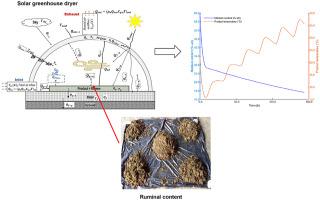Case Studies in Thermal Engineering ( IF 6.4 ) Pub Date : 2021-12-02 , DOI: 10.1016/j.csite.2021.101678 Andrés Colorado 1 , Oswald Morales 2 , Diana Ossa 3 , Andrés Amell 1 , Edwin Chica 4

|
The ruminal content is a biomass waste obtained from the benefit of cattle. This biomass can be used as a fuel for generating part of the thermal energy that is required in the slaughterhouse processes. For this purpose, the ruminal content must be subjected to several pretreatments to facilitate its use as a fuel. The combustion efficiency of the ruminal content is affected by the particle size and the size distribution, as well as the moisture content. The ruminal content has a high moisture content that must be reduced from around 60% to values below 15% (by mass) within a few days so that the conversion efficiency and heating value are not affected. To dry the rumen content, low-cost natural drying systems can be utilized. A numerical approach for the solar greenhouse dryer performance was analyzed for typical local solar irradiation and natural convection conditions, at the greenhouse site of installation. To analyze the rumen content, at variable drying temperatures ranging from 40 °C to 70 °C, a thin layer model was used. Within the temperature range evaluated, the ruminal content effective diffusivity varied from 1.6 × 10−13 to 5.6 × 10−13 m2/s. The dryer was designed as a semi-cylindrical shape with a loading capacity of about 10 000 kg. A set of ordinary differential equations was formulated for modeling and simulating the heat transfer and drying phenomena inside the greenhouse dryer. The method of finite differences was used for solving the system of equations. The estimated drying time of the ruminal content was around 6 days (d) and the final product moisture was 14.10%.
中文翻译:

模拟使用日光温室干燥机干燥瘤胃内容物的最佳条件
瘤胃内容物是从牛的利益中获得的生物质废物。这种生物质可用作产生屠宰过程所需的部分热能的燃料。为此,瘤胃内含物必须经过多次预处理以促进其用作燃料。瘤胃内容物的燃烧效率受颗粒大小和粒度分布以及水分含量的影响。瘤胃内的水分含量很高,必须在几天内从 60% 左右降至 15% 以下(按质量计),这样转换效率和热值不受影响。为了干燥瘤胃内容物,可以使用低成本的自然干燥系统。在温室安装地点,针对典型的局部太阳辐射和自然对流条件,对日光温室干燥机性能的数值方法进行了分析。为了分析瘤胃含量,在 40 °C 至 70 °C 的可变干燥温度下,使用了薄层模型。在评价的温度范围内,瘤胃内含物有效扩散率从 1.6 × 10-13至 5.6 × 10 -13 m 2 /s。干燥机设计为半圆柱形,承载能力约为 10 000 kg。制定了一组常微分方程,用于对温室干燥机内部的传热和干燥现象进行建模和模拟。采用有限差分法求解方程组。瘤胃内容物的估计干燥时间约为 6 天 (d),最终产品水分为 14.10%。











































 京公网安备 11010802027423号
京公网安备 11010802027423号